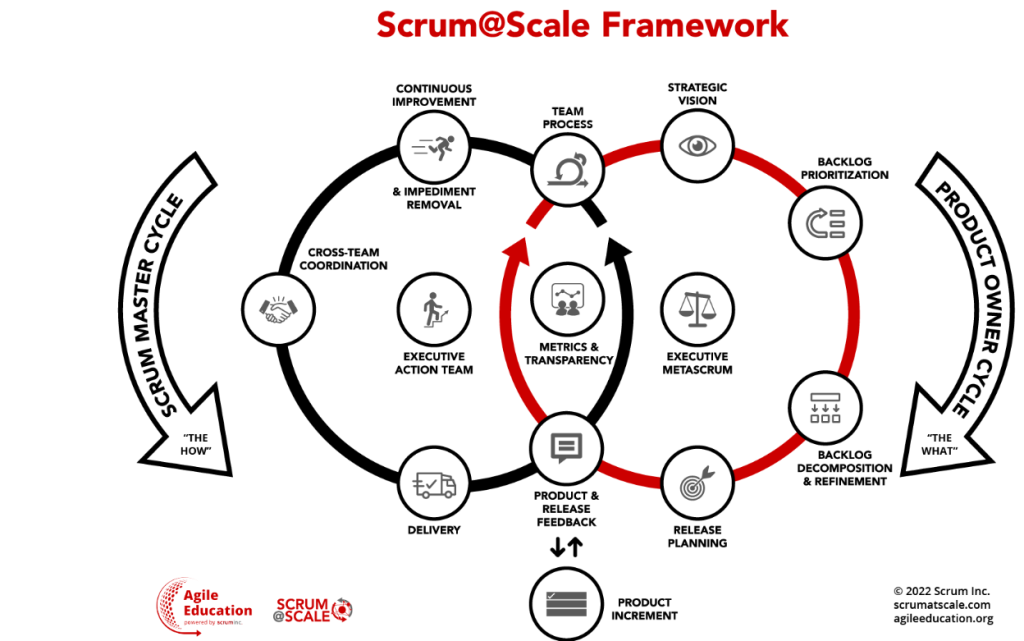Overview Of Scrum @ Scale
This article gives an Overview of Scrum @ Scale. Scrum @ Scale is a framework for Scaling Agile Teams. It is a part of series which explains Different Scaling Frameworks for Agile
The Scrum@Scale guide states that
“Scrum@Scale helps an organization to focus multiple networks of Scrum Teams on prioritized goals. It aims to achieve this by setting up a structure which naturally extends the way a single Scrum Team functions across a network and whose managerial function exists within a minimum viable bureaucracy (MVB).”
In other words, the framework works to extend scrum for one team with minimal overheads

Figure 15 Scrum at Scale
As seen in the diagram, the focus is to keep the what (product) and the how (process) separate. To achieve the same, the framework defines two independent but overlapping cycles: the Scrum Master Cycle for delivery and the Product Owner Cycle for product discovery and definition aligned with your company’s strategic vision and goals.
Each cycle has a leadership group to support effective operation: an Executive MetaScrum (EMS) fulfilling the product owner role at the organization level and an Executive Action Team focused on organization-wide process improvements in the scrum master cycle.
Further Two more additional new roles facilitate the scaled versions of the Scrum events: the Scrum of Scrums Master and the Chief Product Owner.
SaS defines components with a specific purpose in both the product owner and scrum master cycles. They allow you to customize your transformation with tactics beyond the core design and ideas of each.
Scrum@Scale uses the concept of Scrum Of Scrums – which is nothing but a way to implement the above mentioned structure by grouping individual scrum teams in one structure to deliver integrated increments continuously. The Scrum Of Scrum concept elevates each Scrum Events at a “team of teams” level.
Some details about the model are
Scrum Master Cycle
- Scrum of Scrums (SoS) is a new Scrum team that is responsible for fully integrated shippable increments of product at the end of every sprint from all participating teams. SoS teams typically consist of 3-5 people.
- Scrum of Scrums Master (SoSM) is responsible for removing impediments to coordination between SoS teams.
- Scaled Daily Scrum (SDS) is the event where the Scrum Masters from various teams meet to discuss impediments to sprint goals and determine dependencies between each team.
- Executive Action Team (EAT) is a person whose role is to remove impediments that SOS teams cannot remove.
Product Owner Cycle
Scrum@Scale also introduces new roles and concepts in the PO role:
- MetaScrum coordinates a shared backlog that feeds a network of Scrum teams. Their key function is to create a product vision and make it visible to the entire company.
- The Chief Product Owner (CPO) is responsible for the coordination of a single product backlog.
EAT and EMT in Scrum at Scale:
Organizational challenges will multiply when you scale Scrum, therefore Scrum@Scale needs an Executive Action Team (EAT). This team is responsible for the transformation strategy. Its members also own the implementation of Scrum values, roles, and support decision-making.
EAT typically focuses on:
- Ensuring that teams can deliver every sprint;
- Ensuring proper prioritization;
- Ensuring that the company improves continuously.
- The Executive MetaScrum Team (EMT) owns the organizational vision. This team sets strategic priorities for the entire company and is responsible for changing the company’s direction, as well as for deciding which products need to be restructured or retired.
- EMT includes the CPO and business owner with personnel, funding, and customer commitments.
Points to consider
- Scrum at Scale helps organizations to grow in a organic manner at their own pace . The framework allows you to coordinate with multiple teams via scale-free architecture.
- The framework’s concepts are well documented and less prescriptive if compared with other frameworks. Therefore, Scrum at Scale can be applied across the company when Scrum is effectively used at a team level.
- If you strive to apply Scrum@Scale, make sure you focus on Scrum practices before scaling and establish an EAT with the authority to make changes and remove obstacles.